We may ask: do the Nights of Correggio have anything in common with The Nights of Cabiria? Do not gasp folks! Fellini’s heroine (who conveys so much of her authorship) is vividly imbued with a most human joy, a radiant expression of effervescent happiness, sought for herself and others, but languidly overpowered by a mysterious afflatus of failure and death. We will not attempt to decrypt it here, though invited by that treacherous ending, but we would cautiously remind the reader of an almost similar dualism present in the character of Correggio’s art, observed throughout his career.
Antonio Allegri, painter of gladness, has always (from Vasari onward) thunderstruck all critics by the splendor of his painting, by the beatifying radiance of his paintings, by the pervasion of light of his altarpieces, of his frescoes bathed in splendor. Of Correggio it was said, “here is the noontide of art.” For those who have experience of the Po Valley, the noontide of the high season is an estuo of heat, a total and almost unbearable bath of brightness of the vault of the sky. Yes, he who signed himself “laetus” several times transposed light as the dominant element, and as the first element of color drafting, into his compositions. On the restoration scaffolding of the dome of Parma Cathedral, Renato Pasqui showed us the “principle from light” of Correggio’s procedure: a start that was not only technical, but certainly intellectual and psychic. A basic choice that would imbue the whole work, preserving itself always.
But why “the Nights”? Curiously, we can note that the two most famous altarpieces by Nostro were called by the people “The Day” and “The Night.” Here then is the other side, which actually renders the Pittor delle Grazie as an extraordinary master, capable of extracting from the palette daring luministic daring unheard of, and previously judged as impossible (indipingibili would say Eugenio Riccomini). We refer explicitly to compositions placed in the night hours, and thus deprived of any source of natural light. For this reason, and for the rediscovery of a masterpiece, it has occurred to us here to investigate in the general Allegrian corpus such exceptions, which are located in some creative moments quite distant from each other. Let us keep in mind, moreover, that the painter’s very strong personality appears already formed from his advancing youth, and full of tools always ready to adapt to inspirations.
And here is that mysterious link with the bitter ballad of Fellini’s fragile joy: in all of Correggio’s “Nights” death is looming, either immediate or in flickering latitude, but present. And it is a sacred death.
 |
| Correggio, Il Giorno (Madonna del San Girolamo) (oil on panel, 205 x 141 cm; Parma, Galleria Nazionale) It is one of the paradigms of solar pictorial fullness, praised over the centuries. |
About the year 1510, after his apprenticeship with Mantegna, Antonio Allegri (1489 - 1534) had devoted himself to many travels and a widespread study of the masters of various regions; he was certainly struck by the Nordic experiments in the effects of artificial light and wanted to try himself early on this new character that seemed ignored in Italy. Thus the small panel painting that is now the pride of the Musée des Beaux-Arts in Strasbourg became for him a passionate exercise on a theme that the painter kept strongly restricted: the killing of Holofernes by Judith. The episode, taken from the book of Judith (Jdt. 13:18) is that of the slaying of Nebuchadnezzar’s fierce general who was about to destroy the Israelites, but who, seduced by the daring woman in order to save his people, welcomes her into his tent at night and then is beheaded by her in his sleep. The Hebrew heroine, accompanied by her handmaiden, put the enemy’s head in a sack and fled. The event determined the biblical salvation of Israel. Thus, the night and death!
It is important to emphasize how from this painting, executed mostly for himself, Correggio binds himself exactly to the moment of the event (i.e., the darkness within the tent) without seeking the evasions we would call atmospheric of other painters of the time. Everything is extremely concentrated, as we see, and the only source of light is the real one of the flashlight that outlines the aristocratic adergersi and the very elegant profile of Judith along with the deformed scream of the handmaiden and the macabre head plunging into the sack. This is probably the first true nocturne in Italian art, with bright precise flashing colors, pregnant with disturbance and pathos.
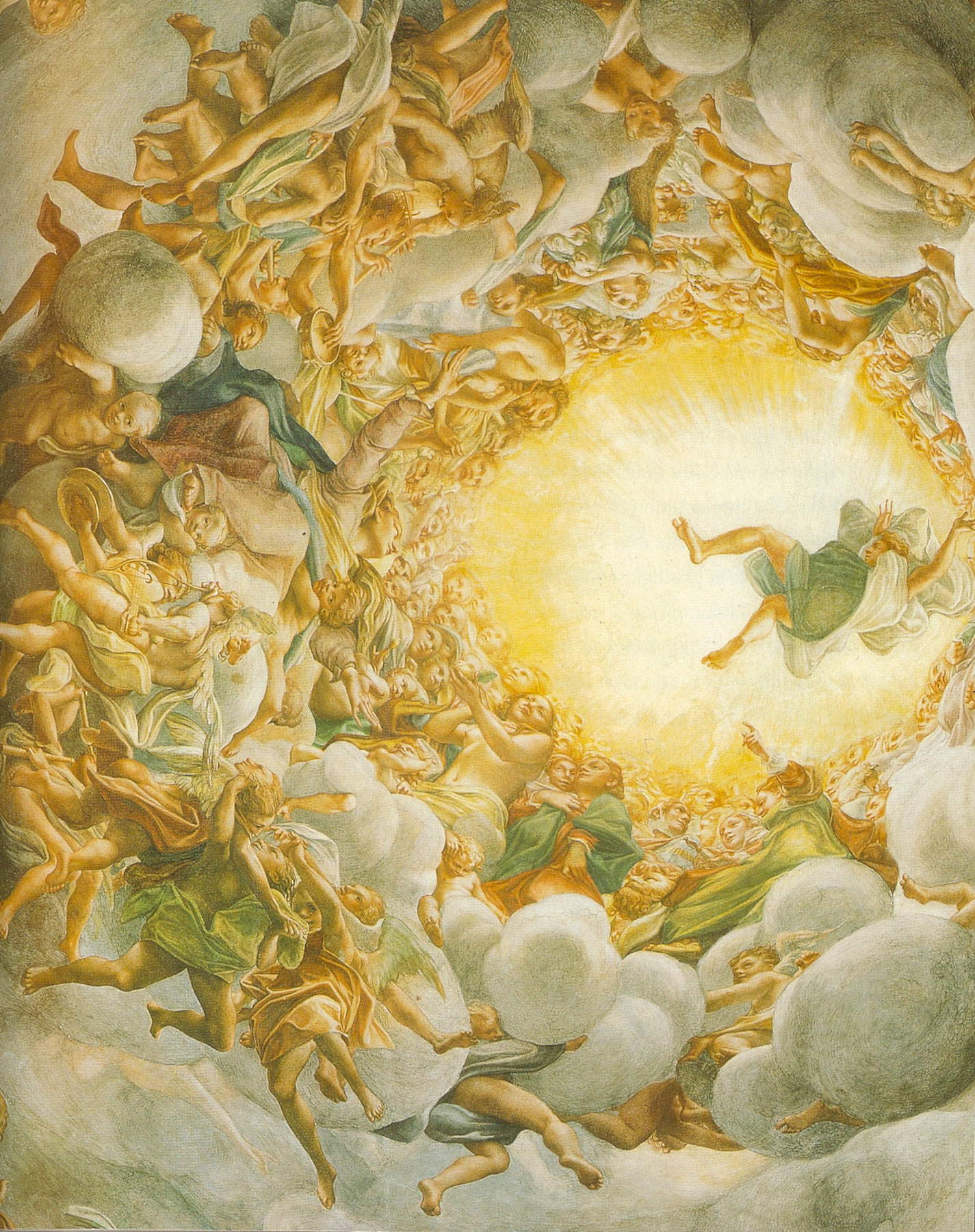 |
| Correggio, Assumption of Mary, detail (fresco in the dome of Parma Cathedral). Ripping through the sky in a dazzling supernal light, Christ descends toward the Mother. |
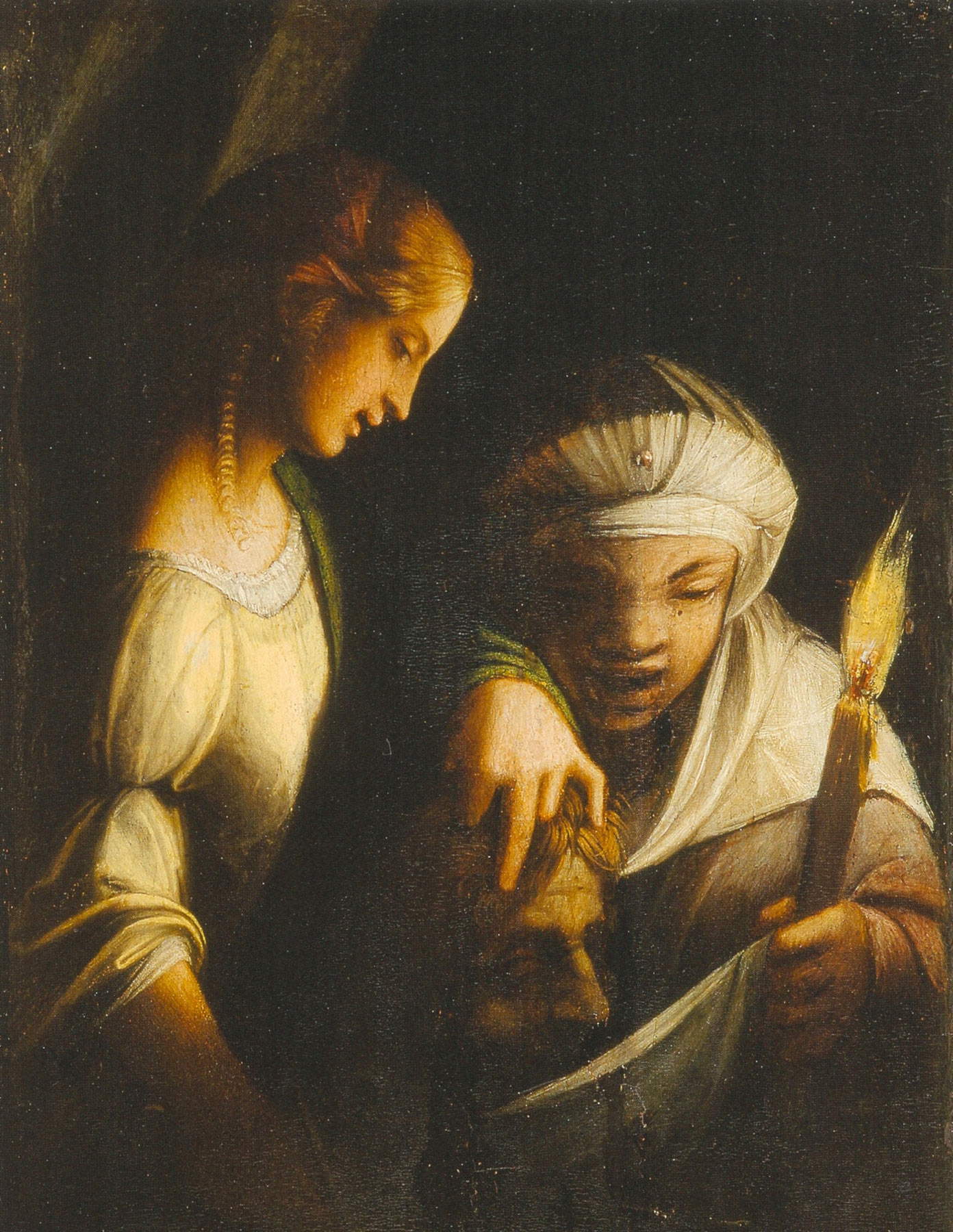 |
| Correggio, Judith and her Handmaid with the Head of Holofernes (oil on panel 27 x 20 cm; Strasbourg, Musée du Beaux-Arts) This is the first evidence of Italian painting in absolute nocturne. An early achievement of the painter eager to experiment with every possibility of language and adherence to historical truth. |
Correggio then favored several extremely elaborate works, including “half-lume,” which made him call the greatest painter of chiaroscuro, but he returned to a nocturnal immersion between 1516 and 1517 when he painted the famous “Zingarella.” Another small panel whose subject matter stems from the intimate thought of a beloved scene, from a choice that can only have descended from personal meditation on the theme of the Flight into Egypt and that wants to focus contemplation exclusively over the motherhood of Mary. A motherhood aware of the divinity of her Son, and trembling over his human destiny, so much so that this Mother gathers all to nest and defend her little child, with an intensity of love that then struck every relative. A most singular and touching composition in the totally shadowy arboreal encroachment after sunset, where only an angelic spirit silently witnesses the two presences of the Gospel moment, while the innocent rabbit admires them.
The fortune of this icon was immense, and copies were immediately made and circulated. Indeed, the profound spirituality that emanates from it is striking; from the very beginning it was recognized as a prelude to the future Pieta, since truly perceived in it is the preconception of the passion and sacrifice of the Son. Caravaggio, an unabashed admirer of Correggio, transposed it directly into his Rest during the Flight into Egypt in the Doria Pamphili Gallery.
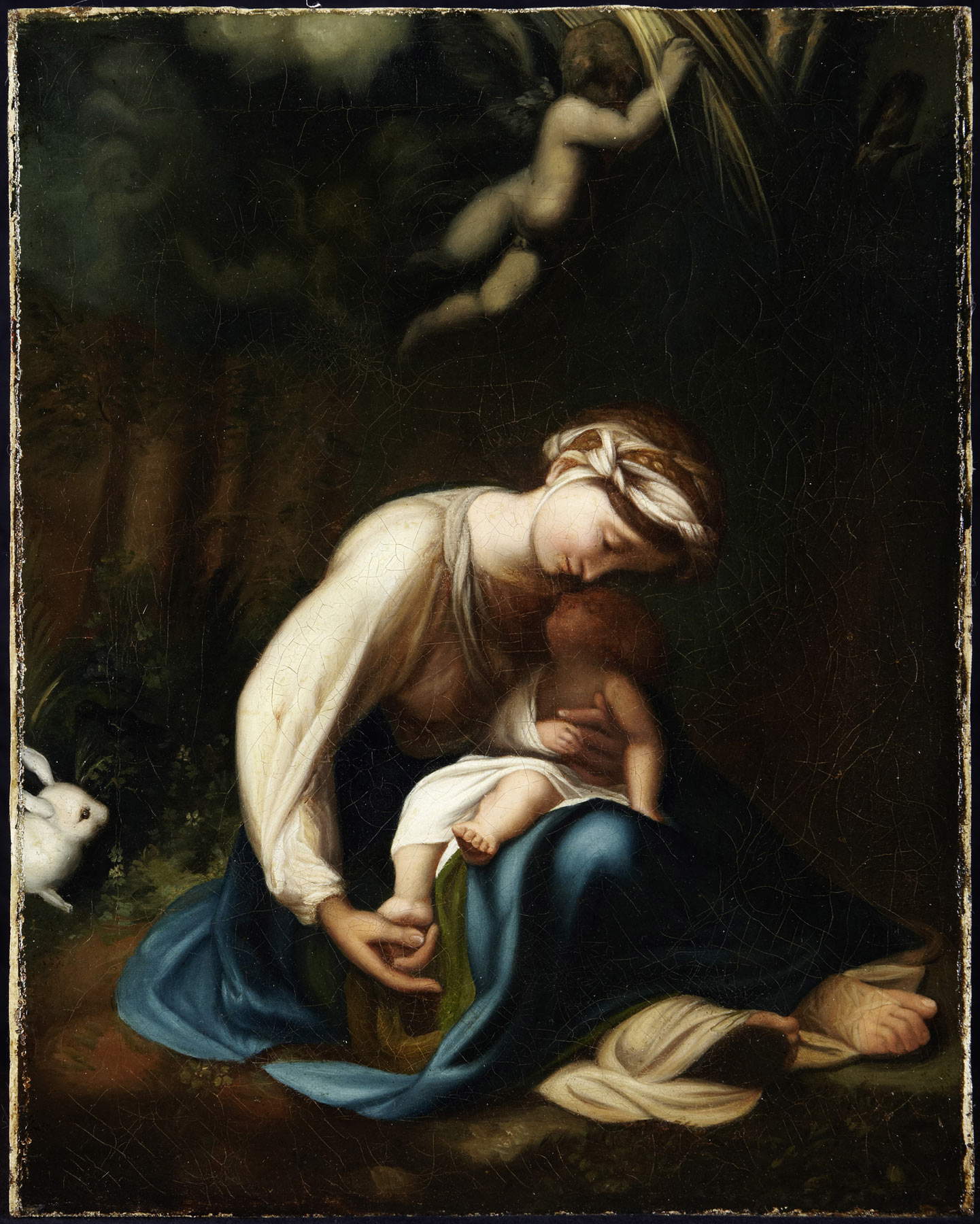 |
| Correggio, The Gypsy (oil on canvas, 46.5 x 37.5 cm; Munich, private collection) All the original elements remain in this exemplar. After sunset Mary encloses her Child for the descending night. |
 |
| Caravaggio, Rest during the Flight into Egypt (oil on canvas, 135.5 x 166.5 cm; Rome, Doria Pamphilj Collection) Caravaggio takes up the mystical poetry of the Zingarella and points to Correggio as his admired source. |
At the end of the gigantic and ingenious undertaking of the frescoes in San Giovanni Evangelista, Parma, between 1524 and 1525 Antonio Allegri devoted himself to some passages from the last events in the life of Christ. It is barely worth mentioning the profound Christian training of this Emilian painter, and also his independence in the choice of his works: indeed, one almost always feels that he preceded the commission and, as it were, prevailed over it: he spoke and demonstrated with great authority! Let us then discuss two very rare themes that Correggio prepared in that phase of his industrious life that we might call the "compassio Christi." We are between 1524 and 1525, and some particular scenes from the Passion of Jesus appear thickly in his catalog, touching on Gospel passages that had been very little frequented before him.
In order we see the Oration in the Garden: other painters, following Matthew’s and Luke’s texts to the letter, placed Christ farther away and the three sleeping apostles closer together, or sought slightly more aligned solutions, but the Nazzarene’s excruciating dialogue with the Father “pass from me this cup if it is possible ....” and the threefold unhelpful call to the sleepy disciples, and finally the descent of the angel to comfort Him from heaven, demanded absolute closeness in this last moment when Jesus openly accepts all the immense sacrifice and death, which He well already knew. And it is here that Correggio, after the greatest anguish of the incarnate God, posits the imminence of the suspended Angel who in the night prodigiously radiates His Lord and comforts Him in His sublime acceptance. The very difficult and ingenious composition almost offers us the frontality of the two protagonists, but it is in the luminous force ripping through the night that this whole impressive masterpiece stands, gripping our souls.
In the Garden of Gethsemane, immediately after the Oration, the events of the terrible night unfold, and Correggio captures a minor one of them with extreme care, painting a subject never directly touched by other painters, namely The Young Man Escaping the Capture of Christ. The canvas, which is not large but has been known and admired through copies since the 16th century, has recently been found in excellent condition, so much so that this recovery must be noted as a resounding event in the context of international artistic culture.
A jewel that, with strong appeal, must be preserved to Italy!
 |
| Correggio, The Oration of Jesus in the Garden (oil on panel, 37 x 40 cm; London, Hapsley House) A full nocturne, resolved by the angel as a radiator of light. The encounter shows Correggio’s brilliant mastery of bodies in the sphericity of space, which Vasari praised supremely. |
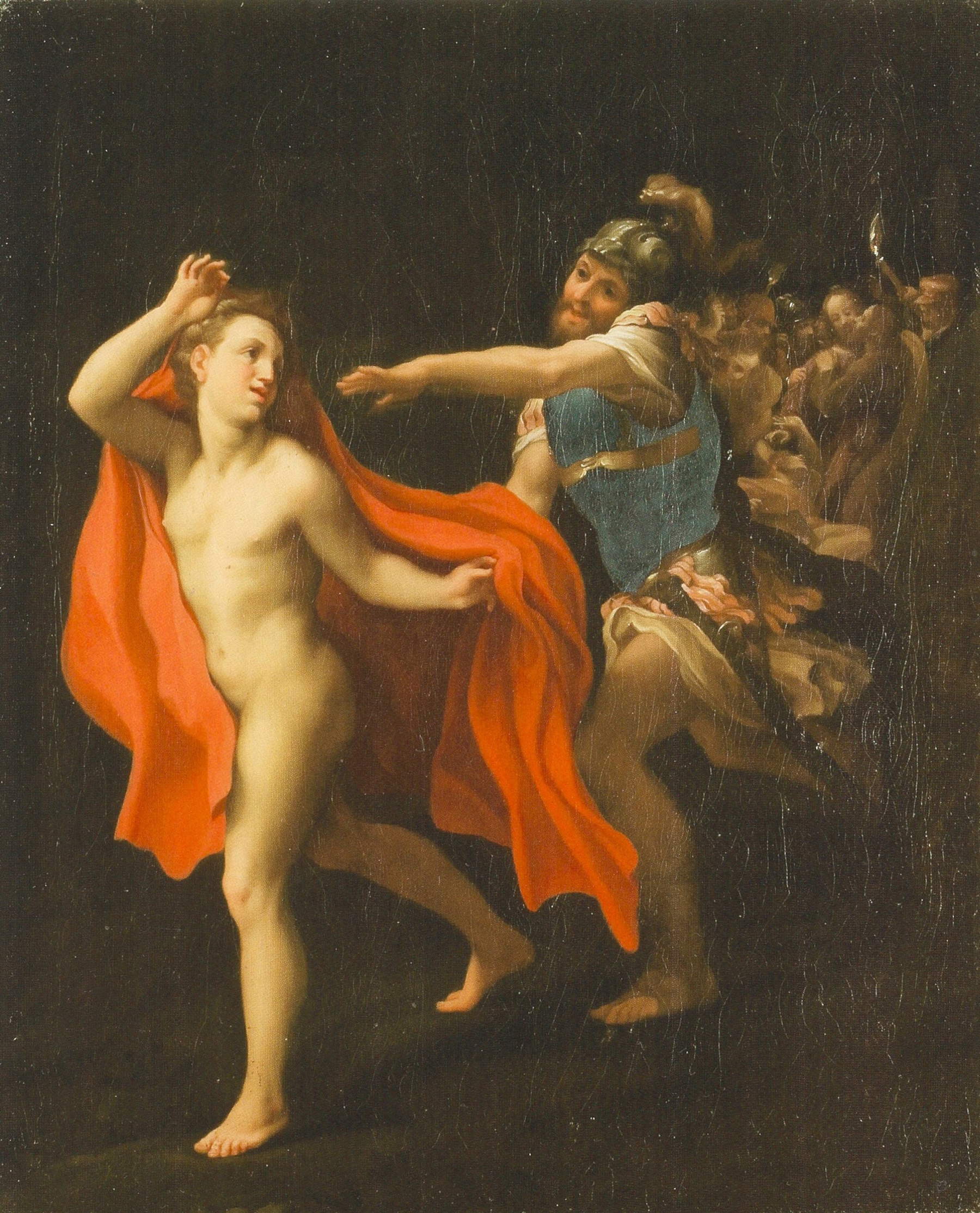 |
| Correggio, Young Man Escaping the Capture of Christ (oil on canvas, 56 x 46 cm; Private property) A unique scene in the context of Italian art, beautifully laid out in movement on many planes. Even in its size, the author’s extreme skill and pungent spontaneity are condensed there. |
Resuming the narrative, we say that after the episode of the ardent prayer the guards led by Judas soon arrive to arrest Christ, who freely surrenders himself, obtaining that his disciples be let go. The group then sets out for Caiaphas’ house, while the apostles disperse, but Mark’s gospel notes a quick episode: a young man follows closely behind Jesus’ group, then the guards try to grab him but he, who was clad only in a cloak, leaves his cloth in their hands and “ran away naked” (Mark 14:50-52). We do not know who that young man was, but he certainly felt a very strong bond with the Lord: this truth struck a particular chord with Correggio, who painted the teenager’s fleeing while in the background Jesus receives a kiss from Judas and reattaches to Malchus that ear Peter had cut off. A nocturnal episode, in complete darkness, as is well captured by the faci carried by the guards, and a prelude to the supremely accepted divine death. Here Correggio creates a scalene moving composition, embriched with chiasms, and obliges himself to offer directly a mystical flash that all irradiates the naked youth, later uncovering the armiger with his trimmings, and that is lost far away: and it is the flash of faith. Here is the dialectic with the darkness of evil.
In 1530 Antonio Allegri delivered to the Chapel of the Pratonieri Family, in the church of San Prospero in Reggio Emilia, what we can call “the Night of Nights.” The “Night” par excellence, which had engaged him since 1522 with trials and pauses, with insights and thoughts: and it is the “Holy Night,” the moment of Jesus’ birth! The theme had enveloped the painter’s soul and led his identification to the sublime truth of God becoming man, of the Redeemer coming down to bring Grace to the world, of the immensity of this act on all creation, and of this infinite gift engaging the Trinity through Mary. Knowing Correggio’s training, his monastic practice, his Christian enthusiasm that continually translated into his pre-imagined visions, his forms, his colors, one can believe that this panel (later described by many as the most beautiful painting in the world) was the result of a special grace.
And it is a “Night” that enters into our theme since the Incarnation of the Word is aimed at the supreme offering of the death of the Cross. But everything here is splendor, everything is light arising from the Babe, from a human body, such as no one had ever thought of and done in painting: a wonder of the master of the heavens; an epiphany of light from the One who would declare “I am the light of the world” (Jn. 8:12). And it is Correggio’s very soul that rejoices, that kindles.
Yes, this is a birth! And it is a birth to die! But then what does that unbridled rejoicing of the angels in heaven mean? It means the glory of the One who will be the Risen One ! Night and light thus merge into saving death and resurrection.
Correggio’s Nights had a Po Valley follower of unparalleled strength: Michelangelo Merisi, known as Caravaggio.
Now, to close again in modernity, we could dredge up the call of a rocker born right in Correggio, Luciano Ligabue, who with his guitar urges us in life not to rest, to always seek, to reach out and understand things: “Some nights the road doesn’t count, and what counts is to feel that you’re going.”
 |
| Correggio, La Notte (Adoration of the Shepherds) (oil on panel, 256.5 x 188 cm; Dresden, Gemäldegalerie) Absolute masterpiece of all time where Allegri’s happiness blossoms to the highest degree with the incredible “inventio” of a childlike body generating light in the world and in the heavens. |
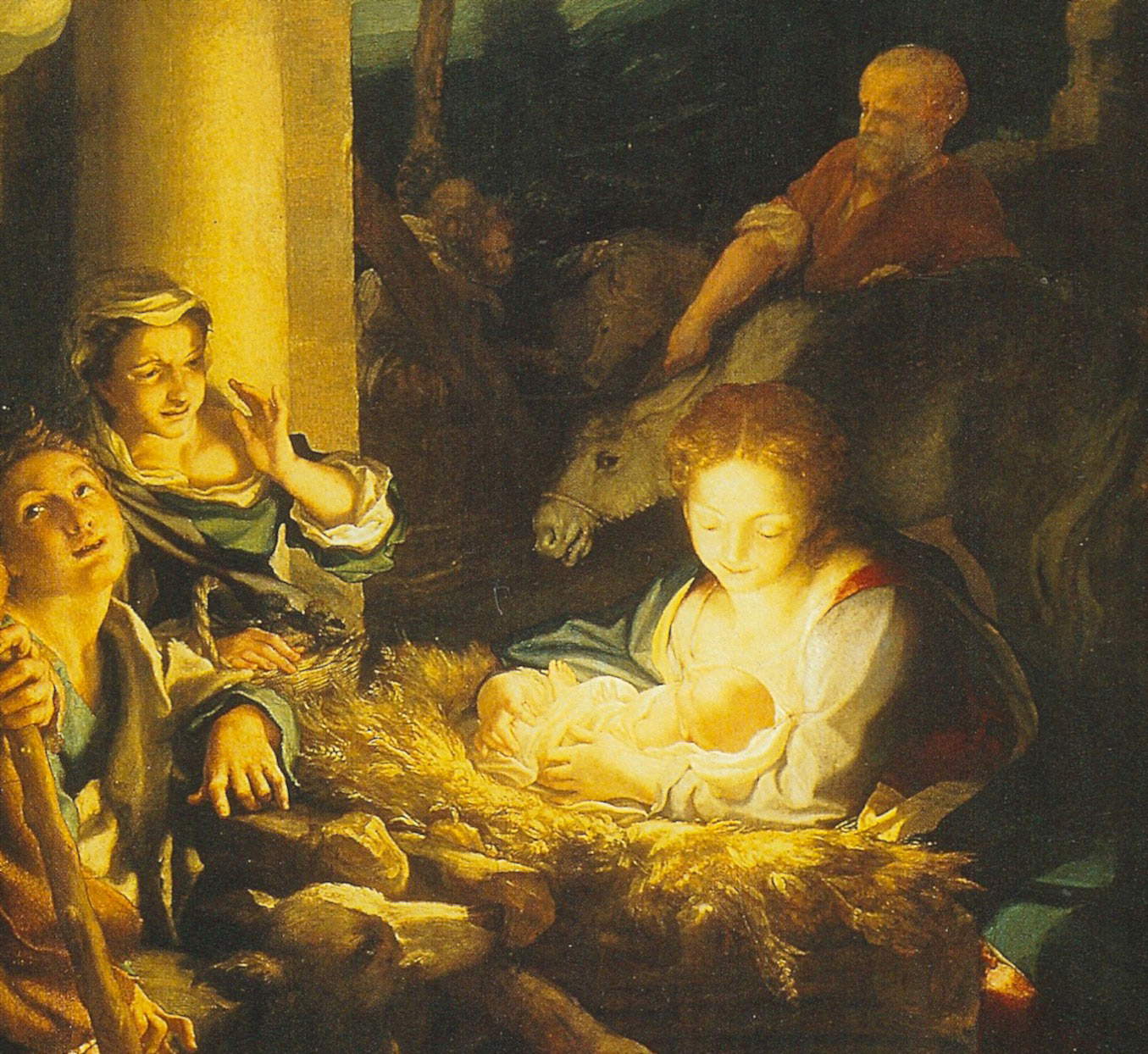 |
|
Correggio, La Notte, detail of the radiating body.
Vasari, deeply impressed, cites the reality of light from the shielding of the eyes of the young shepherdess, who rushed to the manger in Bethlehem. |
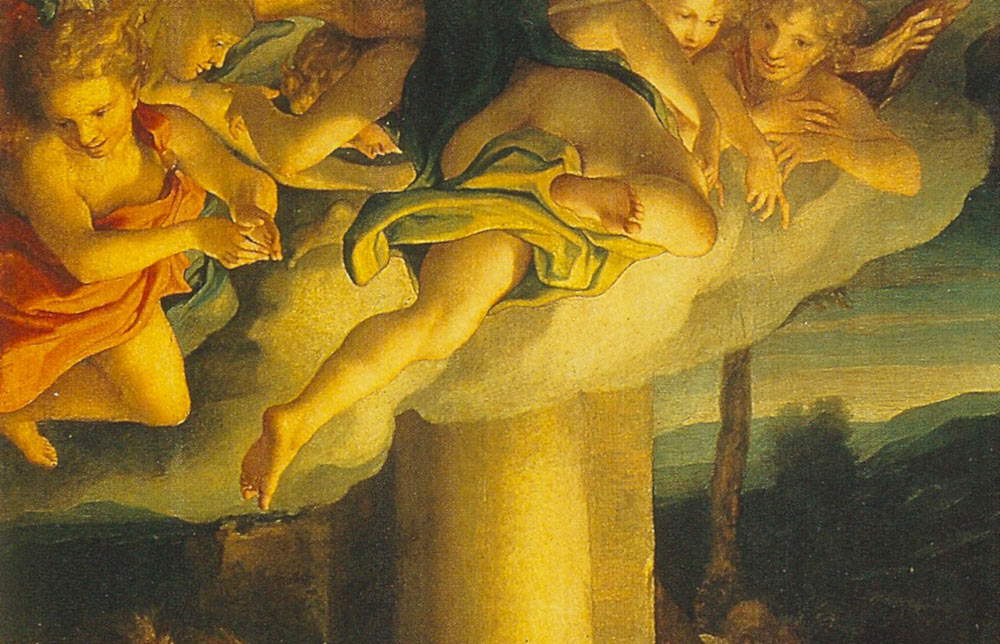 |
|
Correggio, The Night, Angels. Even the angels are illuminated by the tender divine Infant. This totality makes the Incarnation of the Word truly superhuman, as Correggio sees it in ecstasy. |
Warning: the translation into English of the original Italian article was created using automatic tools. We undertake to review all articles, but we do not guarantee the total absence of inaccuracies in the translation due to the program. You can find the original by clicking on the ITA button. If you find any mistake,please contact us.